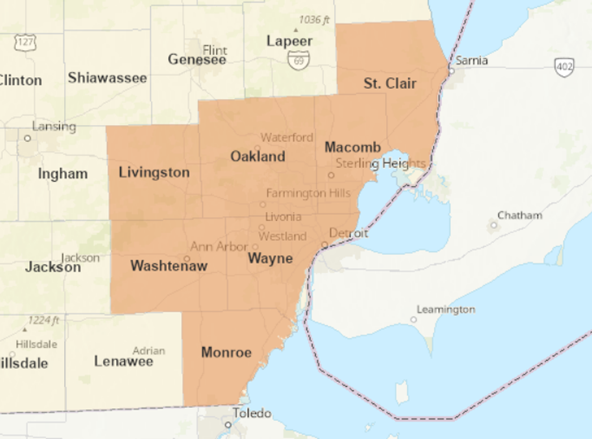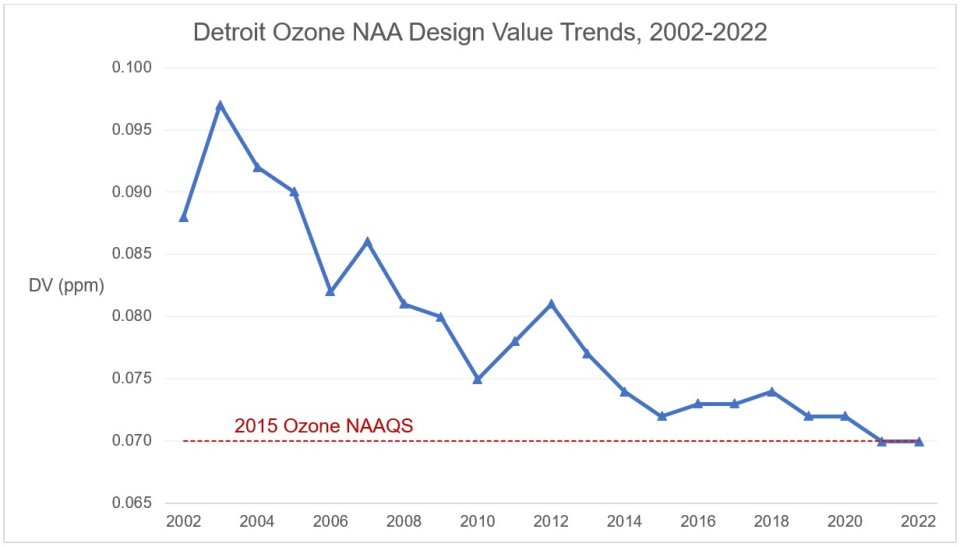Fact Sheet: EPA to Finalize 2015 Ozone Standard Clean Data Determination for the Detroit Metro Area
On this Page:
- Redesignation to Attainment
- Public Comments
- Background
- Clean Data Determination
- Additional Resources

EPA is finalizing a clean data determination for the metro Detroit 8-hour ozone nonattainment area, concluding that the area has monitored attainment of the 2015 8-hour National Ambient Air Quality Standard (NAAQS) for ozone, based upon certified 2020-2022 ozone data. The Detroit nonattainment area, including Livingston, Macomb, Monroe, Oakland, St. Clair, Washtenaw, and Wayne counties, has a 2020-2022 ozone design value of 0.070 parts per million (ppm), which is the threshold for an attainment determination. This determination is based on an analysis from the Michigan Department of Environmental, Great Lakes, and Energy (EGLE) showing that high ozone values measured at an air monitor in Wayne County on June 24 and 25, 2022 were caused by Canadian wildfires.
EPA scientists reviewed and concurred on EGLE’s analysis, which relies on meteorological data, modeling of air mass trajectories, comparisons to historical data, and measurements of brown carbon and black carbon, or soot. Because natural wildfires are not reasonably controllable or preventable, and because EPA scientists identified a clear causal relationship between the wildfires and the monitored smog values, EPA determined that EGLE has satisfied all requirements to exclude the data recorded on June 24 and 25, 2022. Under EPA rules, wildfire impacts may be excluded when calculating attainment of the ozone standard.
The air quality data now shows that the Detroit metro area meets the federal ozone (sometimes referred to as “smog”) standard. Air quality data that shows attainment of the standard is one of the requirements for areas to receive formal air quality “attainment” status under the Clean Air Act.
Public Comments
Comments on the proposed clean data determination were accepted from February 3, 2023 through March 6, 2023. EPA provides responses to comments received in the final rule.
Background
The Clean Data Policy states that EPA can waive certain requirements of the Clean Air Act for designated nonattainment areas where air monitoring data shows the relevant NAAQS have been achieved. This is called a clean data determination and applies as long as air quality continues to meet the standard. Suspended planning elements include:
• reasonable further progress requirements;
• attainment demonstrations;
• reasonably available control measures;
• contingency measures; and
• other state planning requirements related to attainment of the NAAQS.
On October 1, 2015, EPA strengthened the level of the NAAQS for ozone from 0.075 ppm to a more protective 0.070 ppm. As shown in the graph below, ozone in the Detroit area has declined significantly. For the Detroit area, the past twenty years have seen a 28% decrease in ozone concentrations, with additional emission reductions expected to occur in the future. The most recent design value, based on 2020-2022 data, is attaining the standard with a design value of 0.070 ppm. EPA is proposing this clean data determination based on 2020-2022 data.
As discussed in the proposal for this rulemaking, this action does not constitute a redesignation of the area to attainment of the 2015 ozone NAAQS. Although this clean data determination is related to EPA’s redesignation of the Detroit area, regarding the data set used for regulatory purposes, this final action is limited to a clean data determination. EPA is addressing final action on EGLE’s January 3, 2022, redesignation request in a separate action. Read Additional Resources on redesignating the Detroit area to attainment of the 2015 ozone NAAQS.

